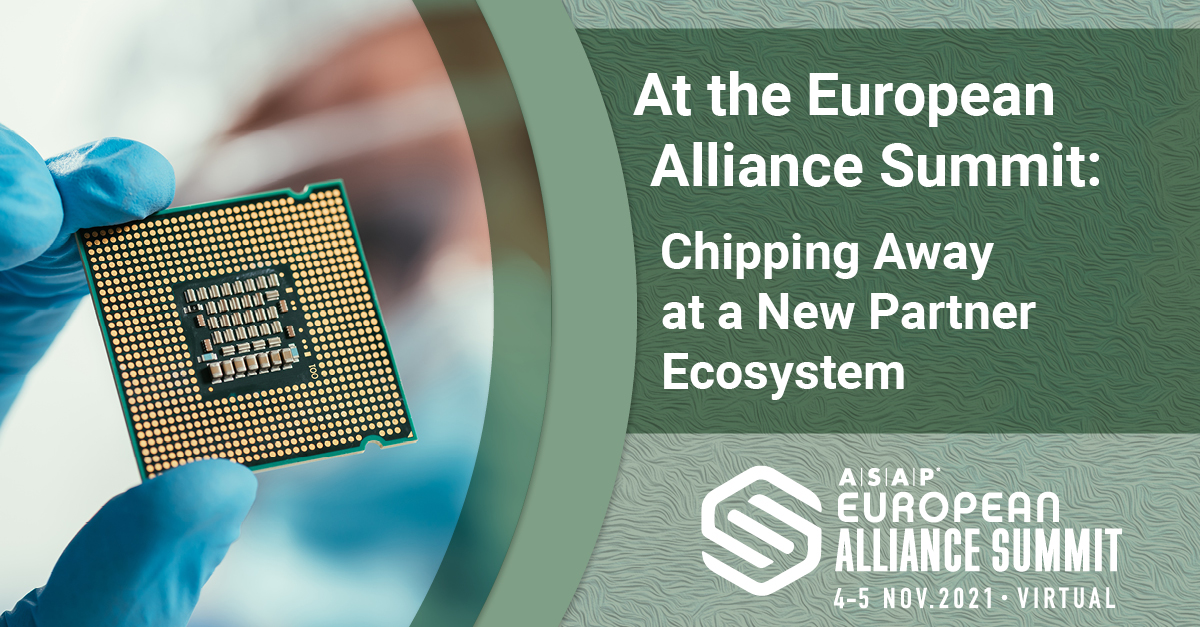Chipping Away at a New Partner Ecosystem
Few industries have undergone changes as dramatic as the semiconductor market over the last decade. Once viewed simply as a tangible commodity serving largely electronic equipment manufacturers, semiconductors are required for just about everything you can think of because pretty much anything can now be connected to the internet. If enterprise IT hardware and software thinks the transition to a services model has upended their businesses, they arguably have nothing on semiconductors, sales of which are expected to grow from $550 billion in 2021 to $1 trillion in 2030.
At November’s 2021 ASAP European Alliance Summit, attendees learned how STMicroelectronics, a $12.6 billion semiconductor company, built a large partner ecosystem to create new digitized products and services and sell them to clients in a variety of industries that a decade ago never dreamed of getting into the electronics industry.
Tune In, Turn On—Here, There, and Everywhere
To give you a sense of how much semiconductor chips have permeated our lives, Alessandro Maloberti, director of partner ecosystems at STMicroelectronics, began his presentation “Business Development via Partnership: Semiconductor Industry” by telling the audience that “from the moment you woke up this morning, you brushed your teeth, got your coffee, and got into your car, you used thousands of chips,” before adding that one particular Audi car model uses more than 200 electronic devices alone.
But while the automobile industry has been no stranger to electronics for many years, many other industries are just beginning to scratch the surface of how IoT capabilities can augment their products and services. For example, Maloberti spoke of a high-end furniture manufacturer that is tinkering with new product designs for desks that will automatically adjust height settings to the user’s chair.
“More and more industries can benefit from electronics to provide value to their customers,” said Maloberti.
However, a majority of these companies don’t know where or how to begin developing this kind of product vision and bringing it to reality. This is creating major market opportunities for companies like STMicroelectronics, which has assembled a partner ecosystem of more than 300 Bluetooth companies, cloud service providers, GPS businesses, sensor manufacturers, integrators, component assemblers, and other players that contribute to the making of IoT services.
Bigger Partners Aren’t Necessarily Better
Maloberti outlined four broad goals for the partner ecosystem: 1) drive adoption of existing company and partner products, 2) market ecosystem solutions to the company’s and partners’ respective networks, 3) create solutions for companies that are newer to the electronics space, and 4) increase joint services business. He added that the company sees four key elements to the ecosystem’s success: 1) partner evaluation and selection, 2) digital infrastructure, 3) support and operational collaboration, and 4) business collaboration.
When STMicroelectronics assesses potential partners, it looks for capabilities in one or more of three areas: technical, marketing, and business. The latter are partners that bring STMicroelectronics into customer engagements to fill a specific product gap in a larger solution. Other partners are opening up new markets more broadly for Maloberti’s company. However, it’s the technical partnerships that have made a big impact on STMicroelectronics’ corporate culture. In the past, the company tended to have a bias toward large corporate allies. But over the last five years, it has discovered many startups and smaller technology providers that have brought novel functionality and expertise.
“They bring something we don’t have. They bring value to the company,” said Maloberti.
Swimming Lessons: Data Lake, Partner Enablement Propel Partners in the Right Direction
At the heart of STMicroelectronics’s partner ecosystem digital infrastructure is advanced analytics.
“We integrate all of the partner data inside the company data lake,” said Maloberti.
With every piece of marketing- and business-related data in one place, STMicroelectronics can run algorithms and place queries that will unearth insights into how partners are currently contributing to the bottom line and how they could potentially increase their impact. Maloberti recommended starting these efforts by collecting data manually and using distributed storage tools before applying advanced technologies to automate data entry and storage in a central database.
“Don’t try to build this database at first stage,” he warned.
STMicroelectronics has advanced its partner enablement capabilities significantly over the past five years. The company now offers an intranet; marketing, product, and sales content; group classes; one-to-one learning sessions; webinars; and partner technology events. It also shares its product roadmap with partners, who in turn have been equally diligent in enabling STMicroelectronics employees.
Sharing Is Caring: Social Media Campaigns and Partner Compensation Drive Partner Engagement
STMicroelectronics’s marketing efforts have done wonders in “[extending] market coverage” and increasing what Maloberti called “earned media.” Partners are creating blog posts, videos, and social media hashtags championing the work of joint initiatives. He said one campaign resulted in a 50 percent increase in marketing reach.
From a broader business perspective, the company is constantly fine-tuning how to better utilize its partnerships to encourage partners to bring new business opportunities and move up the value chain where it is selling more than just silicon but broader joint products and services. This entails cultural change, as well as tweaking of revenue-sharing agreements and compensation models for rewarding partner efforts. (For more insights on the topic, check out the in-depth feature “What’s Happened to Partner Compensation?” in the Q4 2021 Strategic Alliance Quarterly.)
Stay tuned to this blog for more insights from the 2021 ASAP European Alliance Summit throughout the month of January.

